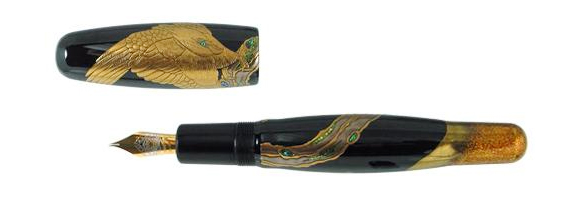Maki‑e pens
Hyotan (Grand Trio)

GRAND TRIO › THE LEGENDARY ANIMALS by Kogaku (Koichiro Okazaki)
Here are the four animals that we selected for this series, painted by Kogaku. Each piece is made with Taka Maki-e and Togidashi Maki-e, with pure gold and platinum. Blue shell Raden and Hirame Kinji (gold dust) are both used as well.

The Phoenix, shown here riding on the cloud of fortune, is a mythical bird to the Japanese. It is a symbol of benevolence; when it appears, it foretells the coming of happiness and prosperity. The phoenix is also known in many of the world’s cultures as a legendary bird.

The Imaginary Lion was regarded as the king of the beasts and a symbol of courage and magnificence. Its head is sacred; a ritual dance with a lion's mask is usually performed at shrines during festivals. Taka and Togidashi Maki-e techniques are used here, with gold and platinum.

The theme was inspired by the well-known Monkey Trio carving on the wall of Toshogu, a shrine built for the famous shogun Tokugawa Ieyasu in Nikko in the 17th century. It is designed with the gestures of the monkeys representing "See no evil", "Say no evil" and "Hear no evil".
GRAND TRIO › TOKAIDO 53 STAGES by Masanori (Masanori Omote)
Tokaido was "Highway 1" in Japan during the Edo period (1603‑1867), stretching between Edo (today's Tokyo) and Kyoto. 300 miles in length, the Japanese used to travel this highway by foot or horseback. The journey would normally take foot travelers at least two weeks. There were at least 50 different establishments along the way: Yado (inns), Yasumi‑Chaya (resting places for tea) or restaurants. Ukiyoe became extremely popular among the Japanese and was practiced by many famous artists such as Hokusai, Hiroshige, Utamaro and Sharaku. Many of their paintings are now Japanese national treasures and are very important collectibles today.

The Maki‑e on the cap is painted by the artist Shojo, and was originally inspired by Hiroshige's “Nihonbashi”, which is today's rebuilt Nihonbashi near the Imperial Place. Nihonbashi was the first station of the Tokaido Highway to Kyoto. The painting on the barrel is Tozuka, which is located in the city of Yokohama, roughly 25 miles from Tokyo. It was considered the second station on the travelers’ journey.

This was inspired by Hokusai's Original Fugaku 36 Kei (36 sceneries); it depicts Mt. Fuji in the morning, with flying cranes on the cap and cranes in the marshes on the barrel. This place was called "Soshu Umezawasa".

This recalls another very famous painting by Hokusai from the Fugaku 36 Kei; "Sanka Haku‑u (Showers under Fuji)" on the cap and the twilight sea at Surugasayu on the barrel.

The scenery of Odawara (50 miles south of Tokyo) is depicted on the cap and Kawagoe on the barrel. The Kawagoe depicts an inventive way of crossing a rivers at that time: travelers using palanquins as their "human vehicles.”
Additional remark: Today's Tokaido has become a highway that runs parallel with the Bullet Train line. If you want to drive from Tokyo to Kyoto, you would have to pay at least US $150.00 in tolls along the highway, including the cost of gas.
GRAND TRIO › NATURE by Yuji (Yuji Ookado)


GRAND TRIO › TOKAIDO 53 STAGES by MASANORI (MASANORI OMOTE)

F58, Hakone is one of the most famous hot spring resorts near Mt. Fuji. In ancient times, Hakone was famous because it was located on the most treacherous mountain pass in Japan. The design on the cap is from Hiroshige's original Tokaido 53Tsugi. The design on the barrel is "Son‑uno Fuji", a view Mt. Fuji from a town on a rainy day (from Hokusai's original drawing of Fugaku 36Kei).

The design on the cap depicts early spring in Mariko, and the design on the barrel depicts winter in Mariko, which was an area known for its Tororo Jiru (special yam soup) served at Chamise (tea shops), several hundred years ago. There are still many restaurants selling this soup today, and there is a place built exactly like the house on the barrel in Hiroshige's picture that sells this soup. There is a temple called Saioku-ji (Saioku temple) at Togetsuho (Togetsu ridge). The name Togetsu means "to puff up the moon," as if the moon is puffed up over the ridge. As depicted on the barrel’s design, the winter in Mariko is very severe and its days dark. The journey onward from this town is another notoriously difficult pass for travelers. Both designs are from Hiroshige's originals of Tokaido 53Tsugi.

Kakegawa was famous for its castle. The Daimyo at the time was Yamanouchi Kazutoyo, who was loyal to Tokugawa Ieyasu after the death of Toyotomi Hiyoshi in 1600. The castle was recently reconstructed, along with some ancient buildings and Buke‑yashiki (Samurai's residences).

The Sanjo Bridge, built by Toyotomi Hideyoshi, was located at Third Street, over Kamo River in Kyoto. If travelers went to Edo (Tokyo) from Kyoto, this bridge was the first station of their journey. A five‑minute walk from the west side of the bridge was a famous hotel called Ikedaya, where the Kinno‑ha (loyalists to the emperor) had been wiped out by Sabaku‑ha, the supporters of the Shogun, and Kondo Isami's Shinsen Gumi (Shinsen Team, similar to hired troops for Tokugawa Shogunate), after planning a coup. The clash, called Ikedaya Sodo, was the beginning of the end of the Shogunate era. The hotel was demolished long ago and there is a monument to this event standing at the site today. Apparently, the building on the site was by a Burger King and is now a "Pachinkoya", a pinball house.


